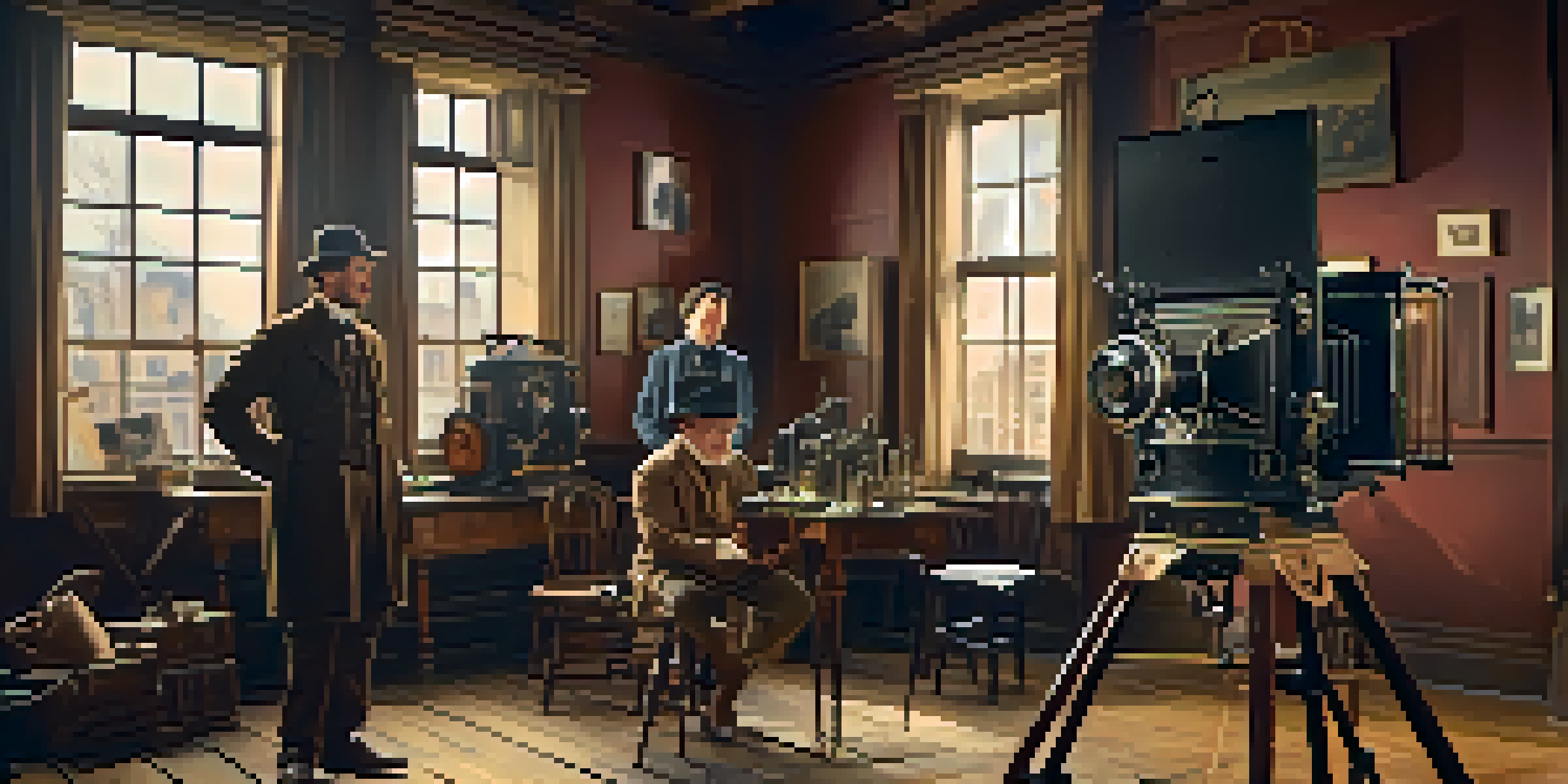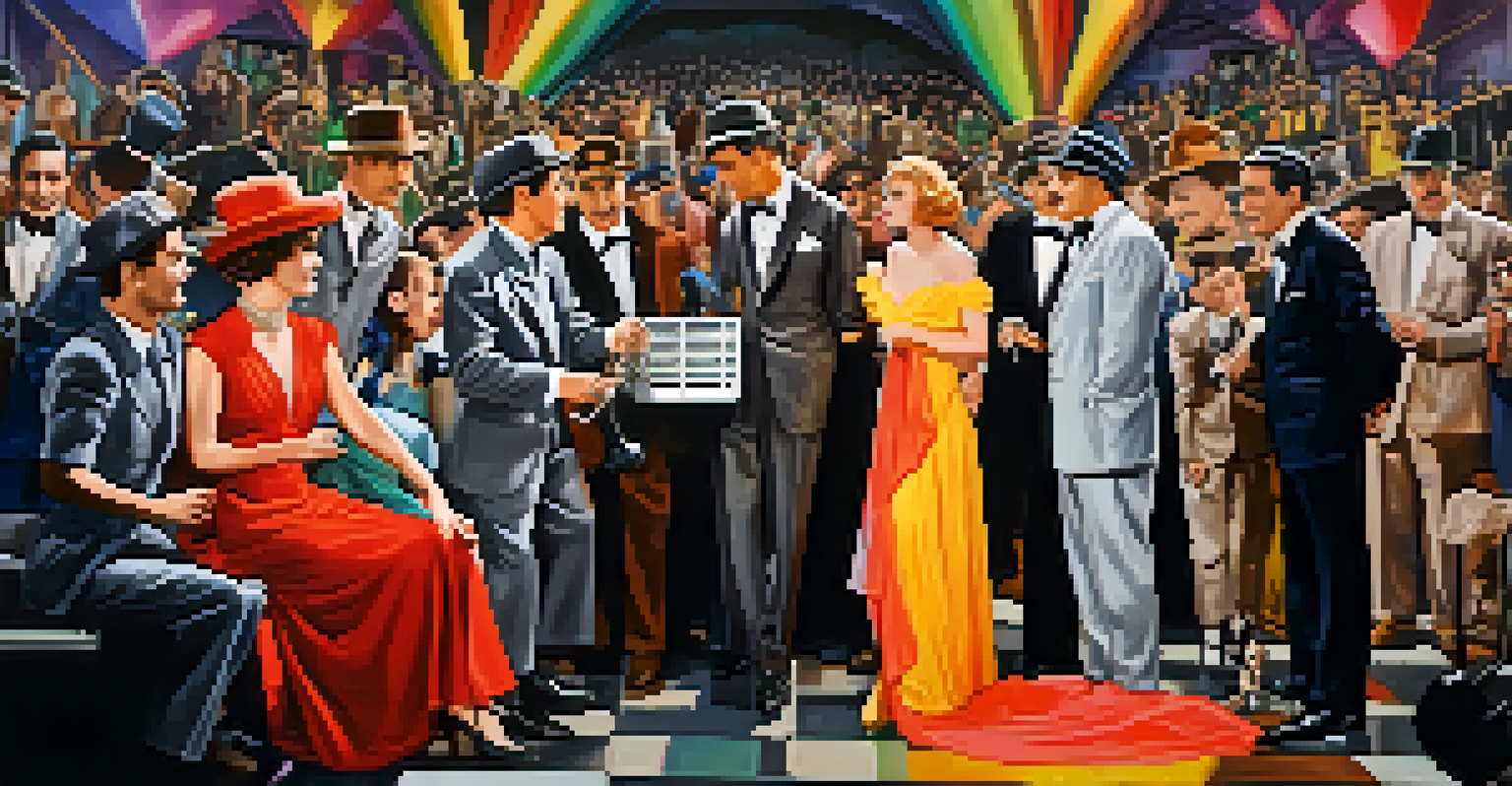The Evolution of Filmmaking: From Traditional to Digital Tools

The Birth of Filmmaking: Early Innovations and Techniques
Filmmaking began in the late 19th century with pioneers like Thomas Edison and the Lumière brothers. They used basic technologies to create short films, capturing everyday life and simple narratives. These early innovations laid the groundwork for storytelling through moving images, sparking the imagination of audiences worldwide.
Film is a powerful means of communication, and its capacity to evoke emotions and convey stories is unparalleled.
As filmmakers experimented, techniques such as editing and special effects began to emerge. The introduction of the motion picture camera allowed for the first time to capture scenes in a way that felt alive and dynamic. This era was marked by a sense of wonder, as filmmakers realized the potential of visual storytelling.
The silent film era thrived, showcasing the power of visual expression without dialogue. Iconic figures like Charlie Chaplin and Buster Keaton became stars by employing physical comedy and expressive acting, proving that a picture could indeed speak a thousand words.
The Rise of Sound and Color: A New Era Begins
With the advent of sound in the late 1920s, filmmaking transformed dramatically. The first 'talkie,' 'The Jazz Singer,' captivated audiences and changed the industry forever. Filmmakers had to adapt their techniques to incorporate dialogue, leading to new storytelling possibilities and challenges.

Color film emerged shortly after, enhancing the visual experience and allowing for more vibrant storytelling. Movies like 'The Wizard of Oz' showcased the impact of color, transporting viewers into fantastical worlds. This evolution made films more immersive and engaging, appealing to a broader audience.
Filmmaking's Rich Historical Journey
From silent films to the digital age, filmmaking has evolved through innovative technologies and techniques that shaped storytelling.
As technology advanced, filmmakers began to explore new genres and styles. The combination of sound and color opened doors to musical films, elaborate productions, and more nuanced storytelling, further solidifying cinema as a vital art form.
The Golden Age of Hollywood: Studio System and Blockbusters
The mid-20th century marked the golden age of Hollywood, characterized by the studio system that controlled the production and distribution of films. Major studios produced big-budget blockbusters, creating a formula for success that included star power and lavish sets. This era solidified the concept of the movie star as a cultural icon.
The movies are a mirror of the world, reflecting the realities and dreams of society.
During this time, filmmakers like Alfred Hitchcock and Orson Welles pushed the boundaries of storytelling and cinematography. Their innovative techniques and unique styles captivated audiences, demonstrating that film could be both a commercial product and a form of artistic expression. The era produced timeless classics that continue to influence filmmakers today.
However, the dominance of the studio system also led to challenges, such as a lack of creative freedom for many filmmakers. As independent cinema began to emerge, a new wave of voices sought to challenge the status quo and tell diverse stories that reflected a broader range of experiences.
The Digital Revolution: Technology Reshapes Filmmaking
The late 20th century saw the rise of digital technology, fundamentally changing the way films are made and consumed. Digital cameras replaced traditional film, offering filmmakers greater flexibility and reducing costs. This shift allowed for a new generation of filmmakers to enter the industry without the need for expensive equipment.
Digital editing software revolutionized the post-production process, making it easier to manipulate footage and create stunning visuals. Filmmakers could now experiment with their storytelling in ways that were previously unimaginable. The barriers to entry lowered, leading to an explosion of creativity and innovation in independent cinema.
Impact of Streaming on Filmmaking
Streaming platforms have revolutionized film distribution, enabling diverse storytelling and greater access for independent filmmakers.
As digital platforms emerged, audiences began to consume films differently. Streaming services like Netflix and YouTube changed the distribution model, allowing filmmakers to reach global audiences without relying solely on traditional theaters. This democratization of filmmaking has led to a diverse range of voices and stories in the industry.
Emerging Technologies: Virtual Reality and Beyond
Today, emerging technologies like virtual reality (VR) and augmented reality (AR) are changing the landscape of filmmaking once again. These technologies allow filmmakers to create immersive experiences that engage audiences in unique ways. Imagine stepping into a film and experiencing the story from within – that’s the promise of VR.
Filmmakers are experimenting with these tools to push the boundaries of narrative and interactivity. Projects like 'The Invisible Man' VR experience showcase how technology can enhance storytelling and create deeper emotional connections with viewers. This evolution is not just about entertainment; it’s about redefining how we experience stories.
As these technologies continue to develop, the future of filmmaking looks bright. Filmmakers are embracing innovation while honoring the art form's rich history, blending traditional techniques with cutting-edge tools to create new cinematic experiences.
The Role of Streaming Platforms in Modern Filmmaking
Streaming platforms have fundamentally altered the filmmaking landscape, providing new avenues for distribution and audience engagement. They have democratized access to films, allowing independent filmmakers to showcase their work to global audiences. This shift has significantly changed how films are marketed and consumed in the digital age.
Platforms like Netflix, Hulu, and Amazon Prime have become major players in film production, funding original content and providing creative freedom to filmmakers. This influx of resources has led to a diverse array of films that might not have found support in traditional studios. Viewers now have access to stories from various cultures and perspectives, enriching the cinematic experience.
Future Trends in Filmmaking
Emerging technologies and a focus on sustainability and inclusivity are set to define the future landscape of filmmaking.
Moreover, the binge-watching trend has influenced how films are structured, with filmmakers considering episodic storytelling. As a result, we see a rise in limited series and mini-series, which allow for deeper character development and more intricate plots. This evolution reflects the changing tastes of audiences and the need for filmmakers to adapt.
The Future of Filmmaking: Trends and Predictions
As we look to the future of filmmaking, several trends are emerging that will shape the industry. The integration of artificial intelligence (AI) in various aspects of production, from scriptwriting to editing, is gaining traction. This technology could streamline processes and offer new creative possibilities, but it also raises questions about the role of human creativity in storytelling.
Sustainability in filmmaking is becoming increasingly important as the industry seeks to reduce its environmental impact. Filmmakers are exploring eco-friendly practices, from using sustainable materials on set to minimizing waste during production. This trend reflects a growing awareness of the need for responsibility in all facets of filmmaking.

As audiences continue to seek authentic and diverse stories, the call for inclusivity and representation in the industry is stronger than ever. Filmmakers are challenged to tell stories that reflect the richness of human experience, fostering a cinematic landscape that resonates with a global audience. The future of filmmaking is exciting, filled with opportunities for innovation and storytelling that transcends boundaries.